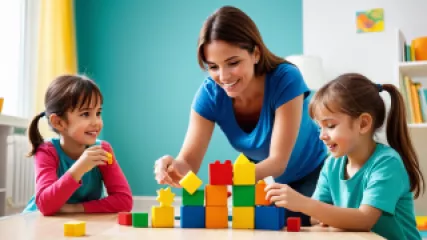Building Resilience in Children: A Step-by-Step Guide
Building Resilience in Children: A Step-by-Step Guide
Raising resilient children is a crucial task for any parent or caregiver. Resilience, the ability to bounce back from adversity and adapt to challenges, is a vital skill that can set children up for success in life. In this step-by-step guide, we'll explore practical strategies and techniques to help build resilience in children, empowering them to navigate the ups and downs of childhood with confidence and positivity.
Understanding Resilience in Children
Resilience is not a trait that some children are born with and others are not. It is a dynamic process that can be cultivated and developed over time. Children who are resilient possess the ability to cope with stress, regulate their emotions, and bounce back from setbacks. They are better equipped to navigate the challenges of childhood, from academic pressures to social conflicts, and emerge stronger as a result.
Resilience in children is shaped by a combination of individual factors, such as temperament and coping strategies, as well as environmental factors, including family, community, and societal support. By understanding the key components of resilience, we can better understand how to foster it in our children.
The Importance of Resilience in Childhood
Developing resilience in children is crucial for their overall well-being and future success. Resilient children are better able to:
- Manage Stress and Emotions: Resilient children have a greater capacity to regulate their emotions, cope with stress, and bounce back from setbacks. This helps them navigate the ups and downs of childhood with greater ease.
- Achieve Academic Success: Resilient children tend to perform better academically, as they are better equipped to overcome academic challenges, stay motivated, and persevere in the face of obstacles.
- Build Stronger Relationships: Resilient children often have healthier and more positive relationships with their peers, family members, and other important figures in their lives.
- Develop a Positive Outlook: Resilient children are more likely to have a optimistic and hopeful outlook on life, which can contribute to their overall well-being and life satisfaction.
- Overcome Adversity: Resilient children are better equipped to navigate and overcome adverse experiences, such as trauma, abuse, or the loss of a loved one, and emerge from these challenges with a sense of growth and empowerment.
By fostering resilience in children, we can help them develop the essential skills and mindset to thrive in the face of life's challenges and setbacks.
The Four Cornerstones of Resilience
Building resilience in children rests on four key cornerstones: a strong support system, emotion regulation skills, problem-solving abilities, and a sense of purpose and meaning. Let's explore each of these in more detail:
1. Developing a Strong Support System
A robust support system is the foundation of resilience. Children need to feel loved, valued, and accepted by the important people in their lives, including their family, friends, and community. This support system provides a sense of security, encouragement, and guidance, which are essential for building resilience.
To cultivate a strong support system for your child, consider the following strategies:
- Nurture Positive Relationships: Spend quality time with your child, engage in open and honest communication, and provide a warm, loving environment where they feel safe to express their emotions.
- Encourage Supportive Friendships: Help your child develop healthy, supportive friendships by facilitating social interactions, playdates, and opportunities to connect with peers.
- Involve the Community: Encourage your child to participate in extracurricular activities, community organizations, or volunteer work, which can help them build a sense of belonging and support outside of the family.
- Access Professional Support: If your child is struggling with mental health or behavioral challenges, seek the guidance of mental health professionals, such as therapists or counselors, who can provide additional support and resources.
2. Fostering Emotion Regulation Skills
Resilient children are able to effectively manage and regulate their emotions. They have the ability to identify, understand, and express their feelings in a healthy and constructive manner. This emotional awareness and regulation are key to building resilience.
To help your child develop emotion regulation skills, consider the following strategies:
- Teach Emotional Literacy: Help your child identify and label their emotions, understand the physical sensations associated with different feelings, and recognize the triggers that elicit those emotions.
- Model Healthy Coping Strategies: Demonstrate and teach your child healthy ways to manage difficult emotions, such as deep breathing, mindfulness, physical activity, or talking it out with a trusted adult.
- Validate and Acknowledge Emotions: When your child expresses their feelings, validate their experience and help them understand that all emotions are valid and acceptable, even if certain behaviors may need to be adjusted.
- Provide a Safe Space to Process Emotions: Create a calm, supportive environment where your child feels comfortable expressing their emotions without fear of judgment or punishment.
3. Developing Problem-Solving Abilities
Resilient children possess the skills to effectively identify and address challenges, obstacles, and problems they encounter. By developing problem-solving abilities, children learn to take a proactive and solution-focused approach to life's challenges.
To help your child develop strong problem-solving skills, consider the following strategies:
- Teach a Problem-Solving Process: Guide your child through a structured problem-solving process, such as identifying the problem, brainstorming possible solutions, evaluating the options, and implementing the chosen solution.
- Encourage Creativity and Flexibility: Inspire your child to think outside the box and consider multiple perspectives when faced with a problem. Help them understand that there may be more than one solution to a problem.
- Foster Independent Thinking: Resist the urge to immediately provide solutions or fix problems for your child. Instead, ask guiding questions that encourage them to think critically and come up with their own ideas.
- Celebrate Effort and Learning: Praise your child's problem-solving efforts, even if the outcome is not what they hoped for. Emphasize the importance of the learning process and reinforce the message that mistakes are opportunities for growth.
4. Cultivating a Sense of Purpose and Meaning
Resilient children have a strong sense of purpose and meaning in their lives. They understand their own unique strengths, interests, and values, and they use these to guide their decisions and actions. This sense of purpose helps children find motivation, direction, and a positive outlook, even in the face of adversity.
To help your child develop a sense of purpose and meaning, consider the following strategies:
- Identify and Nurture Strengths: Help your child recognize and celebrate their unique talents, skills, and abilities. Encourage them to pursue activities and hobbies that align with their interests and strengths.
- Encourage Contribution and Giving Back: Provide opportunities for your child to contribute to their community, whether through volunteering, acts of kindness, or using their skills to help others. This can help them develop a sense of purpose and meaning.
- Foster a Growth Mindset: Teach your child to view challenges and setbacks as opportunities for learning and growth, rather than as insurmountable obstacles. Encourage a "can-do" attitude and a belief in their ability to overcome difficulties.
- Explore Meaningful Values and Beliefs: Engage your child in discussions about their personal values, beliefs, and the things that are most important to them. Help them connect these to their daily lives and decision-making processes.
Putting it All Together: A Step-by-Step Guide to Building Resilience in Children
Now that we've explored the four cornerstones of resilience, let's dive into a step-by-step guide to help you build resilience in your child:
Step 1: Establish a Strong Support System
Begin by nurturing positive, supportive relationships within your child's life. Strengthen your bond with your child, encourage healthy friendships, and connect with your community to create a robust support network. Remember, a strong support system is the foundation upon which resilience is built.
Step 2: Teach Emotion Regulation Skills
Help your child develop the ability to identify, understand, and manage their emotions in a healthy way. Provide a safe space for them to express their feelings, model healthy coping strategies, and validate their emotional experiences. This will empower them to navigate life's challenges with emotional awareness and control.
Step 3: Foster Problem-Solving Abilities
Equip your child with the skills to effectively identify and address challenges. Teach them a structured problem-solving process, encourage creativity and flexibility, and foster independent thinking. Celebrate their efforts and the learning that comes from their problem-solving journey.
Step 4: Cultivate a Sense of Purpose and Meaning
Help your child discover their unique strengths, interests, and values, and guide them in aligning their daily lives with these meaningful components. Provide opportunities for them to contribute to their community and develop a deeper understanding of their role in the world.
Step 5: Celebrate Progress and Setbacks
Throughout the resilience-building process, be sure to celebrate your child's progress and successes, while also acknowledging and validating any setbacks or challenges they face. Reinforce the message that resilience is a lifelong journey, not a destination, and that every step, whether forward or backward, is an opportunity for growth and learning.
Conclusion: Empowering Children for a Resilient Future
Building resilience in children is a transformative journey that equips them with the tools they need to navigate the complexities of life. By focusing on the four cornerstones of resilience - a strong support system, emotion regulation skills, problem-solving abilities, and a sense of purpose and meaning - you can empower your child to thrive in the face of adversity and unlock their full potential.
Remember, resilience is not just a trait, but a dynamic process that can be nurtured and developed over time. With patience, dedication, and a commitment to your child's well-being, you can help them build the resilience they need to overcome obstacles, embrace challenges, and emerge as confident, adaptable, and successful individuals.
Embark on this journey of resilience-building with your child, and witness the transformative power of their growth and development. Together, you can lay the foundation for a future filled with resilience, self-belief, and the unwavering strength to overcome any challenge that comes their way.






